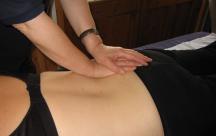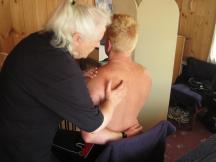Your First Visit
Human Patients
Obviously each practitioner will have a slightly different way of working so this is a very general idea of what you can expect.
When you made your appointment, you will have been told how much time to set aside for your treatment, what to wear and how much it will cost for each visit.
Your first visit will usually involve the taking of a detailed case history, to make sure that a treatment is appropriate. This can include any relevant lifestyle information, accidents, operations and on-going medical problems. We also note current medication(s), your blood pressure may be checked and your weight and height may be measured.
After the treatment procedure has been explained to you, you will be asked for your written consent before the treatment commences.
Since the amendment to the General Data Protection Regulation (GDPR) came into force in May 2018 you will also be asked for your written consent for the practitioner to retain your personal treatment record.
You will be asked to remove some layers of clothing, (usually down to underwear) and a gown can usually be provided upon request to cover your modesty! Some therapists prefer to use towels rather than gowns. There may well be an area behind a screen set aside for disrobing or the therapist will leave the room whilst you undress.
McTimoney-Corley Skeletal Therapists use their fingers very lightly on your skin in order to palpate (feel) where the problems are located.
During the treatment, each part of your skeleton, not just the spine, will be checked and adjusted accordingly.
What happens next?
Your therapist will report on what he/she has discovered and then discuss with you the best course of action to help you.
He/she will probably have given you quite a lot of information during your treatment as to what to expect afterwards. This is not always easy to remember so these are the main items: –
- Keep moving – walk about for a while, it helps your body settle down
- Keep warm – especially if you have received a massage during the treatment
- When you get home, drink lots of water – this helps to flush toxins out of your system
- Sit on a firm chair with a cushion in the small of your back
- The next day, take a shower rather than a bath if possible
N.B. Should your therapist feel that they cannot help you, they will refer you back to your doctor or an appropriate specialist.
After the treatment you will be asked to do very specific exercises designed to help keep your body in its corrected situation. These exercises play a vital part in your recovery so it is important that you carry them out as regularly and as exactly as your McTimoney-Corley Skeletal Therapist suggests.
Reactions to the treatment are many and varied but it is normal to feel tired and/or a little achy all over, straight after the treatment and possibly for two or three days afterwards.
It is not usually necessary to have a follow-up treatment less than a week after the initial one, as your body needs time to adjust to the first treatment. But if you are worried about your body’s reaction to the treatment, please contact your therapist at once.
Animal Patients
Before any animal practitioner can treat your animal, he/she needs veterinary approval – it is against the law for anyone apart from the vet or owner to undertake treatment of an animal. Only veterinarians can carry out surgery or any other invasive treatment e.g., administering injections unless they instruct someone to do so. All McTimoney-Corley Animal Skeletal Therapists should request that you ask for your vet’s permission first. You may be asked to sign a disclaimer to say that you have done this – this is both for your animal’s and the practitioner’s protection.
On arrival the Skeletal Therapist will ask a wide variety of questions, regarding any worries, concerns or problems you have experienced in relation to your animal. They may also ask questions regarding age, breed, feeding regime, worming, inoculations, past treatment, illnesses, temperament, behaviour, fitness program, amount and type of exercise etc. A background history helps to identify what might be causing a particular back problem e.g. a past trauma where the animal had a bad fall may direct their attention to a particular part of your animal’s spine. It is likely that they will request to see your animal move at a walk and/or a faster pace, to identify any lameness and possible gait abnormalities. Horse owners may be requested to ride their horses, especially if the owner has experienced problems whilst riding.
The Skeletal Therapist will then begin to examine your animal more thoroughly firstly to identify any abnormalities e.g., lumps, bumps, old injuries, muscle wastage etc. They may record their findings before, during and after the treatment session using a triplicate receipt pad.
They will give the top copy to the client, the second copy will be for the vet and the third for the therapist’s own records. They will then use their palpation skills to feel for muscle tension, spasms, pain and skeletal misalignments in the spinal area, which may indicate that nerves could be affected and therefore, not functioning properly. Besides palpating the spine, they will also check joints for appropriate range of motion.
After assessing your animal properly, the Skeletal Therapist will then begin to apply appropriate adjustments. These adjustments help to relieve pressure on the nerves, free-up muscle tension/spasm and enable re-alignment of the spine thereby reducing pain. This allows the body to function normally, to its optimum, so it is free to heal itself.
After treatment the Skeletal Therapist will recommend that your animal is rested for a stated number of days. Horse owners will be advised not to ride for a recommended number of days, although alternative types of exercise may be suggested. There is usually no restriction on turnout time.

